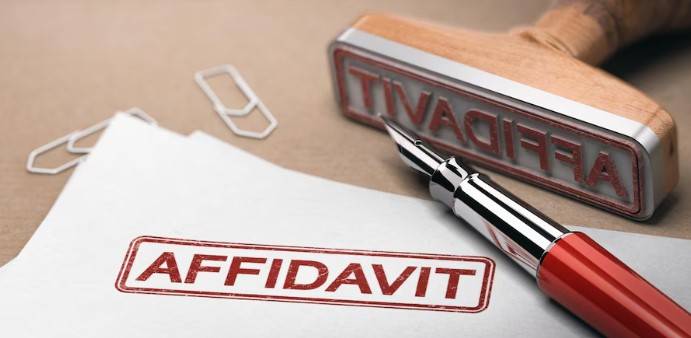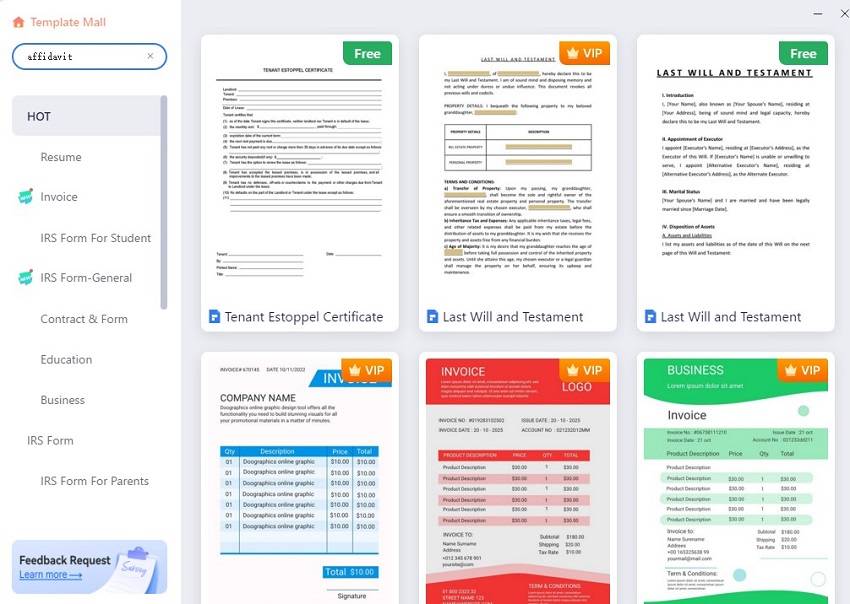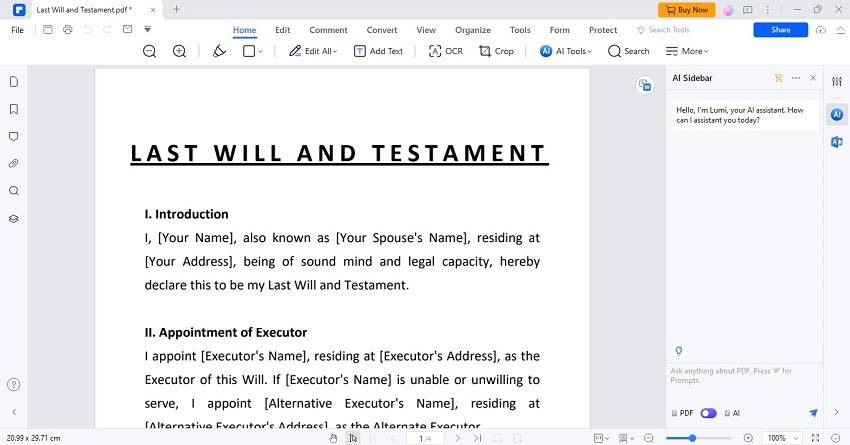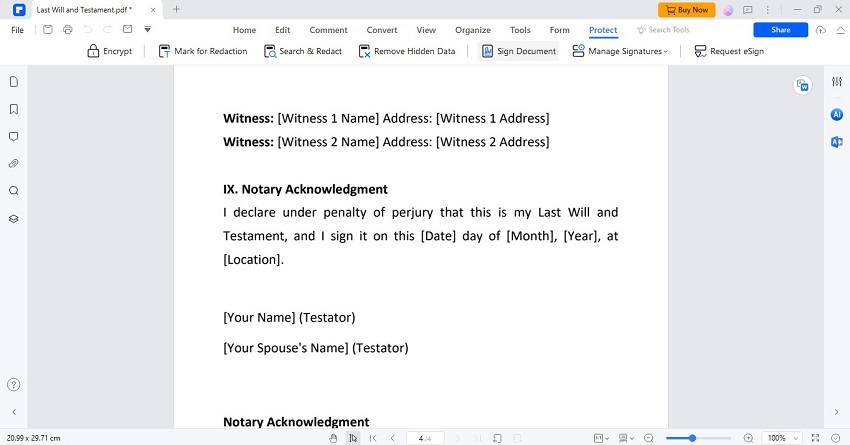An affidavit is a written statement that you swear is true. It is used in court cases. Like a notary public, you sign it before someone with the authority to witness it. This makes it official.
Affidavits are important in legal matters. Knowing how to write an affidavit is important because it helps you tell your side of the story in legal cases. Courts use affidavits to make decisions when people are not there to speak in person. This guide will show you how to write an affidavit in simple steps. This can help make sure your voice is heard clearly in legal matters.
In this article
Part 1. What is an Affidavit?

An affidavit is a written statement you sign under oath. It means you promise that the information in it is true. This document is important in legal settings. People use it to provide evidence when they can't be there in person to speak.
The purpose of an affidavit is to give facts that help solve legal issues. It acts like your voice in a courtroom or other legal situations. It has a strong impact because you swear that the information is true. If you lie in an affidavit, you can face legal consequences. This is because the document has a legal status that the court recognizes.
Affidavits are used in many situations. For example, they are used in court cases, property deals, and personal matters like confirming your address or income. They ensure that important details can be officially recorded and considered, even if you are not there to say them out loud. This helps the court or any other body involved understand the situation better.
Essential Components of an Affidavit
An affidavit must have several key parts to be complete and valid. Here is what should be included:
- Title and Commencement: The title explains the affidavit's purpose. The commencement is the first part, where you state your full name, address, and job.
- Statement of Identity: This part is about who you are, the deponent. It includes your name, age, and where you live. This confirms that you are the person giving the information.
- Content of the Declaration: You write the facts or the story you must tell. You should list these facts. Each fact should start on a new line or be in a separate paragraph.
- Sworn Statement and Signature: In the end, you state that everything you said is true to your knowledge. You sign here to show you agree with this.
- Date and Place: Where and when you make the affidavit. This shows that the information is recent.
- Notarization (if required): Sometimes, you need a notary to watch you sign the affidavit. The notary puts a stamp or seal to prove that you signed it.
These parts ensure that the affidavit is complete and can be used legally.
Types of Affidavits
Affidavits come in different types, depending on what they are used for. Here are some common ones:
- General Affidavit -This is a basic type where you state facts you know are true. It’s used in various situations, like confirming the ownership of property.
- Affidavit of Support - This type is often used in immigration cases. A person signs this to promise they will support someone coming to live in a new country, like a family member.
- Financial Affidavit - This document lists all your money, assets, and debts. It’s used in divorces or loan applications to show how much money you have.
- Affidavit of Service - This proves that legal papers were given to someone else properly. For example, it shows that a notice was delivered to the right person.
- Affidavit of Death - Used to confirm someone’s death, often for legal matters involving wills or insurance.
- Affidavit of Residency - This confirms where someone lives. It might be needed for school registrations or certain legal rights.
Each type of affidavit serves a specific purpose and helps in different legal processes.
Part 2. Preparing an Affidavit
When preparing an affidavit, follow these steps to make sure it is clear and correct:
Step 1
Gathering Necessary Information: Start by collecting all the details you need to include in your affidavit. This includes dates, names, places, and other important facts. Make sure you have everything correct before you start writing.
Step 2
Deciding on the Format: You can write your affidavit in two ways: narrative or point form. A narrative is like telling a story. Point form lists each fact as a separate point. Choose the style that makes your information clearest.
Step 3
Ensuring Clarity and Truthfulness: Your affidavit must be easy to read and understand. Use simple words and short sentences. Avoid legal jargon unless necessary. Most importantly, everything you write must be true. Only include facts that you know are correct. Being honest is crucial because your affidavit is a legal document.
Requirements for a Valid Affidavit
To make sure an affidavit is valid, it must meet certain requirements:
1. Legal Requirements
These include:
- Signature: You must sign the affidavit at the end. This shows that you agree with everything in it.
- Oath: You must swear or promise that the information is true. This usually happens in front of an official, like a notary.
- Notarization: Often, a notary public must watch you sign the affidavit. They put a stamp or seal on it to confirm you signed.
2. Jurisdiction-Specific Requirements
Each place has its own rules for affidavits. For example, some places might require more details about who you are. Others might ask for extra witnesses when you sign. It's important to know the rules of the area where the affidavit will be used.
Always check the specific rules for your location. This ensures that your affidavit is accepted and can be used for its intended purpose. If you are unsure about the rules, you should ask a lawyer or someone who knows about legal documents in your area.
Part 3. Utilizing Wondershare PDFelement in Affidavit Creation

Wondershare PDFelement - PDF Editor Wondershare PDFelement Wondershare PDFelement is a tool that helps you work with PDF documents. It's useful for creating legal documents like affidavits because it's easy to use and has many helpful features.
- PDFelement offers many templates, including ones for affidavits. This makes it easy to start your document without formatting everything from scratch.
- You can digitally sign your affidavit right in the document. This is great for affidavits that need to be sent and signed quickly.
- You can change your affidavit to a PDF or turn a PDF into another type of file. This is helpful when you need to share the document in different formats.
Here's how to create an affidavit using PDFelement:
Step 1
Click on "+," then choose "PDF Template." This opens the Template Mall.

Step 2
Look through the options and pick the template that fits your needs.

Step 3
Click on "Chat with PDF" for help with affidavit-related questions. You can also use features like Summarize, Proofread, and Rewrite PDF.

Step 4
Click "Edit" to make changes to the text. You can add your details and the facts you must include in the affidavit.
Step 5
Use the e-sign feature to put your digital signature on the document.

Step 6
Once your affidavit looks good, save it on your computer or print it out.

Part 4. Notarization of Affidavits
Notarization means that a notary public checks your identity and watches you sign the affidavit. The notary then puts a stamp or seal on the document, showing that your signature is real and that you signed willingly.
Notarization is important because it helps prevent fraud. It assures others, like courts or legal officials, that the signature on the affidavit is genuine and the document is trustworthy. This makes your affidavit stronger as proof in legal matters.
Here's how to get an affidavit notarized:
- Find a Notary. You can find a notary at many banks, law offices, or government buildings. Some libraries and shipping stores also offer notary services.
- Prepare Your Document. Before you go, ensure your affidavit is complete, but do not sign it yet. You need to sign in front of the notary.
- Bring Identification. Take a valid ID, such as a driver's license or passport. The notary needs to check your identity.
- Sign the Affidavit. Do this in front of the notary. They will watch you sign to make sure it's you.
- Notary’s Stamp. After you sign, the notary will stamp or seal the document. They might also make notes about the notarization in their records.
Tips for Writing an Effective Affidavit
Writing a clear and effective affidavit is crucial. Here are some tips to help you:
- Use easy words and short sentences. Make sure each sentence clearly states one fact or idea.
- Only include things you know are true because you saw them or were involved. List each fact separately. This helps the reader understand better.
- Stick to what is necessary for your legal matter. Do not include your feelings or thoughts about the situation.
Here are some sample sentences and phrases in an affidavit:
- "I saw the car stop at the red light."
- "The meeting took place at noon."
- "I received the payment on March 5, 2023."
- "The document was signed in my presence."
These tips and examples will help you write an affidavit that is easy to read and legally effective. Always remember to check your facts and keep your writing straightforward.
Conclusion
Knowing how to write an affidavit correctly is crucial because it plays a key role in legal matters. Using PDFelement can make this process easier and more accurate. It offers tools like templates and e-signing that help you create clear and professional affidavits. Consider trying PDFelement to ensure your legal documents are well-prepared and meet all necessary standards.

 G2 Rating: 4.5/5 |
G2 Rating: 4.5/5 |  100% Secure
100% Secure



